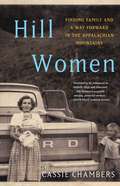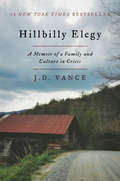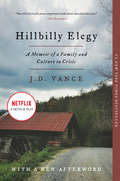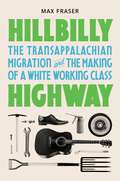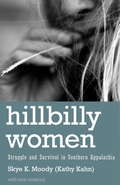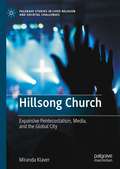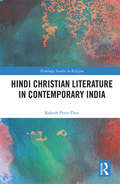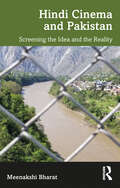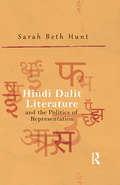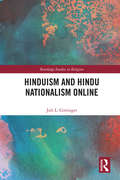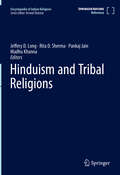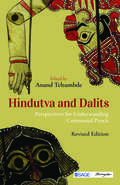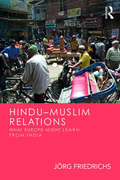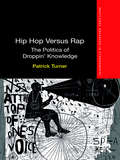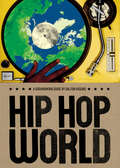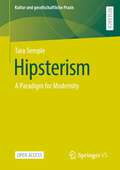- Table View
- List View
Hill Women: Finding Family and a Way Forward in the Appalachian Mountains
by Cassie ChambersAfter rising from poverty to earn two Ivy League degrees, an Appalachian lawyer pays tribute to the strong &“hill women&” who raised and inspired her, and whose values have the potential to rejuvenate a struggling region—an uplifting and eye-opening memoir for readers of Hillbilly Elegy and Educated. Nestled in the Appalachian mountains, Owsley County is one of the poorest counties in both Kentucky and the country. Buildings are crumbling and fields sit vacant, as tobacco farming and coal mining decline. But strong women are finding creative ways to subsist in their hollers in the hills. Cassie Chambers grew up in these hollers and, through the women who raised her, she traces her own path out of and back into the Kentucky mountains. Chambers&’s Granny was a child bride who rose before dawn every morning to raise seven children. Despite her poverty, she wouldn&’t hesitate to give the last bite of pie or vegetables from her garden to a struggling neighbor. Her two daughters took very different paths: strong-willed Ruth—the hardest-working tobacco farmer in the county—stayed on the family farm, while spirited Wilma—the sixth child—became the first in the family to graduate from high school, then moved an hour away for college. Married at nineteen and pregnant with Cassie a few months later, Wilma beat the odds to finish school. She raised her daughter to think she could move mountains, like the ones that kept her safe but also isolated her from the larger world. Cassie would spend much of her childhood with Granny and Ruth in the hills of Owsley County, both while Wilma was in college and after. With her &“hill women&” values guiding her, Cassie went on to graduate from Harvard Law. But while the Ivy League gave her knowledge and opportunities, its privileged world felt far from her reality, and she moved back home to help her fellow rural Kentucky women by providing free legal services. Appalachian women face issues that are all too common: domestic violence, the opioid crisis, a world that seems more divided by the day. But they are also community leaders, keeping their towns together in the face of a system that continually fails them. With nuance and heart, Chambers uses these women&’s stories paired with her own journey to break down the myth of the hillbilly and illuminate a region whose poor communities, especially women, can lead it into the future.
Hill Women: Finding Family and a Way Forward in the Appalachian Mountains
by Cassie ChambersNestled in the Appalachian mountains, Owsley County is one of the poorest counties in both Kentucky and the country. Buildings are crumbling and fields sit vacant, as tobacco farming and coal mining decline. But strong women are finding creative ways to subsist in their hollers in the hills. Cassie Chambers grew up in these hollers and, through the women who raised her, she traces her own path out of and back into the Kentucky mountains. <p><p> Chambers’s Granny was a child bride who rose before dawn every morning to raise seven children. Despite her poverty, she wouldn’t hesitate to give the last bite of pie or vegetables from her garden to a struggling neighbor. Her two daughters took very different paths: strong-willed Ruth—the hardest-working tobacco farmer in the county—stayed on the family farm, while spirited Wilma—the sixth child—became the first in the family to graduate from high school, then moved an hour away for college. Married at nineteen and pregnant with Cassie a few months later, Wilma beat the odds to finish school. She raised her daughter to think she could move mountains, like the ones that kept her safe but also isolated her from the larger world. <p><p> Cassie would spend much of her childhood with Granny and Ruth in the hills of Owsley County, both while Wilma was in college and after. With her “hill women” values guiding her, Cassie went on to graduate from Harvard Law. But while the Ivy League gave her knowledge and opportunities, its privileged world felt far from her reality, and she moved back home to help her fellow rural Kentucky women by providing free legal services. Appalachian women face issues that are all too common: domestic violence, the opioid crisis, a world that seems more divided by the day. But they are also community leaders, keeping their towns together in the face of a system that continually fails them. <p><p> With nuance and heart, Chambers uses these women’s stories paired with her own journey to break down the myth of the hillbilly and illuminate a region whose poor communities, especially women, can lead it into the future.
Hillbilly Elegy: A Memoir of a Family and Culture in Crisis
by J. D. Vance<P>From a former marine and Yale Law School graduate, a powerful account of growing up in a poor Rust Belt town that offers a broader, probing look at the struggles of America's white working class. <P>Hillbilly Elegy is a passionate and personal analysis of a culture in crisis--that of white working-class Americans. The decline of this group, a demographic of our country that has been slowly disintegrating over forty years, has been reported on with growing frequency and alarm, but has never before been written about as searingly from the inside. J. D. Vance tells the true story of what a social, regional, and class decline feels like when you were born with it hung around your neck. <P>The Vance family story begins hopefully in postwar America. J. D.'s grandparents were "dirt poor and in love," and moved north from Kentucky's Appalachia region to Ohio in the hopes of escaping the dreadful poverty around them. They raised a middle-class family, and eventually their grandchild (the author) would graduate from Yale Law School, a conventional marker of their success in achieving generational upward mobility. <P>But as the family saga of Hillbilly Elegy plays out, we learn that this is only the short, superficial version. Vance's grandparents, aunt, uncle, sister, and, most of all, his mother, struggled profoundly with the demands of their new middle-class life, and were never able to fully escape the legacy of abuse, alcoholism, poverty, and trauma so characteristic of their part of America. Vance piercingly shows how he himself still carries around the demons of their chaotic family history. <P>A deeply moving memoir with its share of humor and vividly colorful figures, Hillbilly Elegy is the story of how upward mobility really feels. And it is an urgent and troubling meditation on the loss of the American dream for a large segment of this country. <P><b>A New York Times Bestseller</b>
Hillbilly Elegy: A Memoir of a Family and Culture in Crisis
by J. D. VanceHillbilly Elegy recounts J.D. Vance's powerful origin story...From a former marine and Yale Law School graduate now serving as a U.S. Senator from Ohio and the Republican Vice Presidential candidate for the 2024 election, an incisive account of growing up in a poor Rust Belt town that offers a broader, probing look at the struggles of America's white working class.THE #1 NEW YORK TIMES BESTSELLER"You will not read a more important book about America this year."—The Economist"A riveting book."—The Wall Street Journal"Essential reading."—David Brooks, New York TimesHillbilly Elegy is a passionate and personal analysis of a culture in crisis—that of white working-class Americans. The disintegration of this group, a process that has been slowly occurring now for more than forty years, has been reported with growing frequency and alarm, but has never before been written about as searingly from the inside. J. D. Vance tells the true story of what a social, regional, and class decline feels like when you were born with it hung around your neck.The Vance family story begins hopefully in postwar America. J. D.'s grandparents were "dirt poor and in love," and moved north from Kentucky's Appalachia region to Ohio in the hopes of escaping the dreadful poverty around them. They raised a middle-class family, and eventually one of their grandchildren would graduate from Yale Law School, a conventional marker of success in achieving generational upward mobility. But as the family saga of Hillbilly Elegy plays out, we learn that J.D.'s grandparents, aunt, uncle, and, most of all, his mother struggled profoundly with the demands of their new middle-class life, never fully escaping the legacy of abuse, alcoholism, poverty, and trauma so characteristic of their part of America. With piercing honesty, Vance shows how he himself still carries around the demons of his chaotic family history.A deeply moving memoir, with its share of humor and vividly colorful figures, Hillbilly Elegy is the story of how upward mobility really feels. And it is an urgent and troubling meditation on the loss of the American dream for a large segment of this country.
Hillbilly Hellraisers: Federal Power and Populist Defiance in the Ozarks
by J. Blake Perkins J PerkinsJ. Blake Perkins searches for the roots of rural defiance in the Ozarks--and discovers how it changed over time. Eschewing generalities, Perkins focuses on the experiences and attitudes of rural people themselves as they interacted with government in the late nineteenth and twentieth centuries. He uncovers the reasons local disputes and uneven access to government power fostered markedly different reactions by hill people as time went by. Resistance in the earlier period sprang from upland small farmers' conflicts with capitalist elites who held the local levers of federal power. But as industry and agribusiness displaced family farms after World War II, a conservative cohort of town business elites, local political officials, and Midwestern immigrants arose from the region's new low-wage, union-averse economy. As Perkins argues, this modern anti-government conservatism bore little resemblance to the populist backcountry populism of an earlier age but had much in common with the movement elsewhere.
Hillbilly Highway: The Transappalachian Migration and the Making of a White Working Class (Politics and Society in Modern America #157)
by Max Fraser&“The best book to explain the world J. D. Vance came from is Max Fraser&’s Hillbilly Highway.&”—Jessica Wilkerson, author of To Live Here, You Have to Fight: How Women Led Appalachian Movements for Social JusticeOver the first two-thirds of the twentieth century, as many as eight million whites left the economically depressed southern countryside and migrated to the booming factory towns and cities of the industrial Midwest in search of work. The "hillbilly highway" was one of the largest internal relocations of poor and working people in American history, yet it has largely escaped close study by historians. In Hillbilly Highway, Max Fraser recovers the long-overlooked story of this massive demographic event and reveals how it has profoundly influenced American history and culture—from the modern industrial labor movement and the postwar urban crisis to the rise of today&’s white working-class conservatives.The book draws on a diverse range of sources—from government reports, industry archives, and union records to novels, memoirs, oral histories, and country music—to narrate the distinctive class experience that unfolded across the Transappalachian migration during these critical decades. As the migration became a terrain of both social advancement and marginalization, it knit together white working-class communities across the Upper South and the Midwest—bringing into being a new cultural region that remains a contested battleground in American politics to the present.The compelling story of an important and neglected chapter in American history, Hillbilly Highway upends conventional wisdom about the enduring political and cultural consequences of the great migration of white southerners in the twentieth century.
Hillbilly Women: Struggle and Survival in Southern Appalachia
by Skye Moody"This book tells what it means to be a woman when you are poor, when you are proud, and when you are a hillbilly." First published in 1973, Skye Moody's Hillbilly Women shares the stunning and raw oral histories of nineteen women in twentieth-century Southern Appalachia, from their day-to-day struggles for survival to the personal triumphs of their hardscrabble existence. They are wives, widows, and daughters of coal miners; factory hands, tobacco graders, cotton mill workers, and farmers; and women who value honest labor, self-esteem, and dignity. Shining a much-needed light into a misunderstood culture and identity, the stories within reflect the universally human struggle to live meaningful and dignified lives.Updated with a new introduction and material from the author.
Hillsong Church: Expansive Pentecostalism, Media, and the Global City (Palgrave Studies in Lived Religion and Societal Challenges)
by Miranda KlaverThis book highlights the expansion of the influential Pentecostal Hillsong Church global megachurch network from Australia across global cities. Ethnographic research in Amsterdam and New York City shows that global cities harbor nodes in transnational religious networks in which media play a crucial role. By taking a lived religion approach, media is regarded as integral part of everyday practices of interaction, expression and consumption of religion. Key question raised is how processes of mediatization shape, alter and challenge this thriving cosmopolitan expression of Pentecostalism. Current debates in the study of religion are addressed: religious belonging and community in global cities; the interrelation between media technology, religious practices and beliefs; religion, media and social engagement in global cities; media and emerging modes of religious leadership and authority. In this empirical study, pressing societal issues like institutional responses to sexual abuse of children, views on gender roles, misogyny and mediated constructions of femininity are discussed.
Hindi Christian Literature in Contemporary India (Routledge Studies in Religion)
by Rakesh Peter-DassThis is the first academic study of Christian literature in Hindi and its role in the politics of language and religion in contemporary India. In public portrayals, Hindi has been the language of Hindus and Urdu the language of Muslims, but Christians have been usually been associated with the English of the foreign ‘West’. However, this book shows how Christian writers in India have adopted Hindi in order to promote a form of Christianity that can be seen as Indian, desī, and rooted in the religio-linguistic world of the Hindi belt. Using three case studies, the book demonstrates how Hindi Christian writing strategically presents Christianity as linguistically Hindi, culturally Indian, and theologically informed by other faiths. These works are written to sway public perceptions by promoting particular forms of citizenship in the context of fostering the use of Hindi. Examining the content and context of Christian attention to Hindi, it is shown to have been deployed as a political and cultural tool by Christians in India. This book gives an important insight into the link between language and religion in India. As such, it will be of great interest to scholars of Religion in India, World Christianity, Religion and Politics and Interreligious Dialogue, as well as Religious Studies and South Asian Studies.
Hindi Cinema and Pakistan: Screening the Idea and the Reality
by Meenakshi BharatEver since the 1947 partition of the Indian subcontinent, Mumbai-based Hindi cinema has been returning compulsively to the idea of Pakistan, sometimes as the desirable other, sometimes as the horrifying antagonist. Hindi Cinema and Pakistan traces the genesis and development of this theme in Hindi cinema in the 1950s, showcasing its relevance as a tool that both reflects and shapes how India sees its neighbour, the India–Pakistan relationship, and itself.The book is a serious, multi-platform, multi-pronged exploration of the appearances, invocations, representations and treatment of Pakistan and Pakistanis in Hindi cinema. It follows Hindi cinema’s efforts to come to terms with the ‘idea’ and ‘reality’ of Pakistan. Through in-depth analyses of the enmity and rivalry between the two subcontinental nations in Partition films, thrillers, epic war films and sports films, to screen depictions of the shared cultural past and similarities in films on cross-border love or in films that show a reaching out through humour, this book investigates the visualization of Pakistan and contextualizes these representations within the broader frameworks of India’s political, socio-cultural and popular discourse.The extensive reach of the in-depth textual analyses of Hindi cinema will make this volume interesting and valuable both to the lay reader and to researchers and academics of cultural studies, media and film studies, and the study of socio-psychological violence in media and culture.
Hindi Dalit Literature and the Politics of Representation
by Sarah Beth HuntThis study explores how Dalits in north India have used literature as a means of protest against caste oppression. Including fresh ethnographic research and interviews, it traces the trajectory of modern Dalit writing in Hindi and its pivotal role in the creation, rise and reinforcement of a distinctive Dalit identity. The book challenges the existing impression of Hindi Dalit literature as stemming from the Dalit political assertion of the 1980s and as being chiefly imitative of the Marathi Dalit literature model. Arguing that Hindi Dalit literature has a much longer history in north India, it examines two differing strands that have taken root in Dalit expression — the early ‘popular’ production of smaller literary pamphlets and journals at the beginning of the 20th century and more contemporary modes such as autobiographies, short stories and literary criticism. The author highlights the ways in which such various forms of literary works have supported the proliferation of an all-encompassing identity for the so-called ‘untouchable’ castes. She also underscores how these have contributed to their evolving political consciousness and consolidation of newer heterogeneous identities, making a departure from their long-perceived image. The work will be important for those in Dalit studies, subaltern history, Hindi literature, postcolonial studies, political science and sociology as well as the informed general reader.
Hinduism and Hindu Nationalism Online (Routledge Studies in Religion)
by Juli L. GittingerThe way people encounter ideas of Hinduism online is often shaped by global discourses of religion, pervasive Orientalism and (post)colonial scholarship. This book addresses a gap in the scholarly debate around defining Hinduism by demonstrating the role of online discourses in generating and projecting images of Hindu religion and culture. This study surveys a wide range of propaganda, websites and social media in which definitions of Hinduism are debated. In particular, it focuses on the role of Hindu nationalism in the presentation and management of Hinduism in the electronic public sphere. Hindu nationalist parties and individuals are highly invested in discussions and presentations of Hinduism online, and actively shape discourses through a variety of strategies. Analysing Hindu nationalist propaganda, cyber activist movements and social media presence, as well as exploring methodological strategies that are useful to the field of religion and media in general, the book concludes by showing how these discourses function in the wider Hindu diaspora. Building on religion and media research by highlighting mechanical and hermeneutic issues of the Internet and how it affects how we encounter Hinduism online, this book will be of significant interest to scholars of religious studies, Hindu studies and digital media.
Hinduism and Tribal Religions (Encyclopedia of Indian Religions)
by Madhu Khanna Pankaj Jain Rita D. Sherma Jeffery D. LongThis volume offers an overview of Hinduism as found in India and the diaspora. Exploring Hinduism in India in dynamic interaction, rather than in isolation, the volume discusses the relation of Hinduism with other religions of Indian origin and with religions which did not originate in India but have been a major feature of its religious landscape. These latter religions include Islam and Christianity and, to a lesser extent, Zoroastrianism and Judaism. The volume also covers Hinduism’s close association with Tribal Religions, sometimes called Primal Religions. As its second main theme, the volume examines the phenomenon of Hinduism in the diaspora. The Indian diaspora is now beginning to make its presence felt, both in India and abroad. In India, the Indian government annually hosts a diaspora event called Pravasi Bharatiya Divas (PBD), in recognition of the growing importance of the twenty-million-strong diaspora. Although not all Indians are Hindus, most are, both in India and abroad, and a strong sense of Hindu identity is emerging among diasporic Hindus. This volume fills the need felt by Hindus both in India and the diaspora for more knowledge about modern-day Hinduism, Hindu history and traditions. It takes into account three main aspects of Hinduism: that the active pan-Indian and diasporic language of the Hindus is English; that modern Hindus need a rational rather than a devotional or traditional exposition of the religion; and that they need information about and arguments to address the stereotypes which characterize the presentation of Hinduism in academia and the media, especially in the West.
Hindutva and Dalits: Perspectives for Understanding Communal Praxis
by Anand TeltumbdeDespite the teachings of Babasaheb Ambedkar against Hinduism and its pernicious caste system, which he forsook to become a Buddhist, many Dalits have turned to Hindutva. The RSS under Balasaheb Deoras began to appropriate Ambedkar, engaging with Dalits and Adivasis, Hinduizing their beliefs, providing social welfare and binding them in a political alliance. Hindutva and Dalits: Perspectives for Understanding Communal Praxis takes a comprehensive view of the birth and growth of the Hindutva movement and its specific impact on Dalits. Part I, Theoretical Perspectives, explores the attitude of Hindutva vis-à-vis Dalits in its various manifestations. Part II, Hindutva in Operation, covers empirical evidence of its impact on Dalits. The contributors, distinguished scholar-activists, offer a provocative analysis on why both Dalits and Adivasis are drawn to Hindutva. As analysed by Tanika Sarkar in her incisive Foreword, Hindutva’s hegemonic agenda lets ‘subalterns develop a stake in their own subordination, … not in resignation or despair but in eager self-identification with it’. The great strength of this collection is that it asks difficult questions that need to be asked and yet have no easy answers. The book, thus, makes an invaluable contribution to the debate and takes it forward.
Hindu–Muslim Relations: What Europe Might Learn from India
by Jörg FriedrichsThis book reconstructs Hindu–Muslim relations from a European standpoint. Drawing from the Indian context, the author explores options for Western Europe – a region grappling with the refugee crisis and populist reactions to the growth of Muslim minorities. The author shows how India can serve not only as a model but also as a warning for Europe. For example, European liberals may learn not only from the achievements of Indian secularism but also from its crisis. Based on extensive interviews with Indians from diverse backgrounds, from politicians to social activists and from the middle class to slum dwellers, the volume investigates a wide range of perspectives: Hindu and Muslim, religious and secular, moderate and militant. Relevant, engaging and accessible, this book speaks to a broad audience of concerned citizens and policy makers. Scholars of political science, sociology, modern history, cultural studies and South Asian studies will be particularly interested.
Hip Hop Versus Rap: The Politics of Droppin' Knowledge (Routledge Advances in Ethnography)
by Patrick Turner'What is the real hip hop?' 'To whom does hip hop belong?' 'For what constructive purposes can hip hop be put to use?' These are three key questions posed by hip hop activists in Hip Hop Versus Rap, which explores the politics of cultural authenticity, ownership, and uplift in London’s post-hip hop scene. The book is an ethnographic study of the identity, role, formation, and practices of the organic intellectuals that populate and propagate this ‘conscious’ hip hop milieu. Turner provides an insightful examination of the work of artists and practitioners who use hip hop ‘off-street’ in the spheres of youth work, education, and theatre to raise consciousness and to develop artistic and personal skills. Hip Hop Versus Rap seeks to portray how cultural activism, which styles itself grassroots and mature, is framed around a discursive opposition between what is authentic and ethical in hip hop culture and what is counterfeit and corrupt. Turner identifies that this play of difference, framed as an ethical schism, also presents hip hop’s organic intellectuals with a narrative that enables them to align their insurgent values with those of policy and to thereby receive institutional support. This enlightening volume will be of interest to post-graduates and scholars interested in hip hop studies; youth work; critical pedagogy; young people and crime/justice; the politics of race/racism; the politics of youth/education; urban governance; social movement studies; street culture studies; and vernacular studies.
Hip Hop World: A Groundwork Guide (Groundwork Guides)
by Dalton HigginsA fascinating look at hip hop, the world’s most popular music, and what it means to young people all over the globe, written by an acclaimed pop-culture critic. An excellent introduction to hip hop for young adults. Hip hop is arguably the predominant global youth subculture of this generation. In this book Dalton Higgins takes vivid snapshots of the hip hop scenes in Europe, North America, Asia, Africa and more. American hip hop has gone through growing pains, and is questioned for being too commercialized to articulate the hopes, concerns and dreams of marginal youth and community members. Outside the US, hip hop culture is often a political tool to mobilize disenfranchised communities around hard issues, with little support from mainstream corporations or sponsors. Higgins taps into his own powers of pop culture prognostication to predict the future of the genre and the youth culture that spawned it, as hip hop spreads its tentacles to the furthest reaches of humanity. "[The Groundwork Guides] are excellent books, mandatory for school libraries and the increasing body of young people prepared to take ownership of the situations and problems previous generations have left them." — Globe and Mail Correlates to the Common Core State Standards in English Language Arts: CCSS.ELA-LITERACY.RI.6.1 Cite textual evidence to support analysis of what the text says explicitly as well as inferences drawn from the text. CCSS.ELA-LITERACY.RI.6.2 Determine a central idea of a text and how it is conveyed through particular details; provide a summary of the text distinct from personal opinions or judgments. CCSS.ELA-LITERACY.RI.6.3 Analyze in detail how a key individual, event, or idea is introduced, illustrated, and elaborated in a text (e.g., through examples or anecdotes). CCSS.ELA-LITERACY.RI.6.6 Determine an author's point of view or purpose in a text and explain how it is conveyed in the text.
Hipsterism: A Paradigm for Modernity (Kultur und gesellschaftliche Praxis)
by Tara SempleThis Open-Access-book utilises Hipsterism to demonstrate modes of identity, collectivity, conceptions and a whole spectrum of activities with varying degrees of commitment in contemporary society. Analysed through the lens of Modernity, Consumerism, and the New Spirit of Capitalism, it draws on qualitative research from two subsequent field stays in Berlin and is complemented by self-reflexion within the field. Young adults and their conceptions within modernity, capitalism and consumerism constitute a fundamental building block to understanding society. Little sociological work has been done in the field of Hipsterism, although it can function as a paradigm for western, affluent societies. With tools such as conscious consumption, conversations and ethical or creative work within a politically intended lifestyle, Hipsterism emerges as an attempt to navigate between individualism and collectivity. Resulting from these circumstances are a variety of forms of action, while searching for better ways to contribute and engage at the same time. Attempts to dissolve milieus and try to construct spaces where different cultures, classes and ethnicities are welcome might fail in spatial practice, but the practices in sum still leave a trace in (consumer) culture. All these activities hint at the potential of transformative and negotiating power that Hipsterism could have.This is an open access book.
Hire Purpose: How Smart Companies Can Close the Skills Gap
by Greg Shaw Deanna MulliganThe future of work is already here, and what this future looks like must be a pressing concern for the current generation of leaders in both the private and public sectors. In the next ten to fifteen years, rapid change in a post-pandemic world and emerging technology will revolutionize nearly every job, eliminate some, and create new forms of work that we have yet to imagine. How can we survive and thrive in the face of such drastic change?Deanna Mulligan offers a practical, broad-minded look at the effects of workplace evolution and automation and why the private sector needs to lead the charge in shaping a values-based response. With a focus on the power of education, Mulligan proposes that the solutions to workforce upheaval lie in reskilling and retraining for individuals and companies adapting to rapid change. By creating lifelong learning opportunities that break down boundaries between the classroom and the workplace, businesses can foster personal and career well-being and growth for their employees. Drawing on her own experiences, historical examples, and reports from the frontiers where these issues are unfolding, Mulligan details how business leaders can prepare for and respond to technological disruption. Providing a framework for concrete and meaningful action, Hire Purpose is an essential read about the transformations that will shape the next decade and beyond.
Hire With Your Head: Using Performance-Based Hiring to Build Outstanding Diverse Teams
by Lou AdlerDiscover the secrets of one of the world’s leading talent acquisition experts In the newly revised Fourth Edition of Hire With Your Head: Using Performance-Based Hiring to Build Great Teams, influential recruiting and hiring expert Lou Adler delivers a practical guide to consistently identifying and hiring the best people and scaling that process throughout your company. This book will help you address your hiring and recruitment issues, not just by making you more efficient, but also by reforming your entire process to align with how top talent actually look for new jobs, compare offers, and select opportunities. You'll discover: Discover what it takes to ensure more Win-Win Hiring outcomes by hiring for the anniversary date rather than the start date How to use a "High Tech, High Touch" approach to raise the talent bar Expand the talent pool to include more outstanding, high potential and diverse talent by defining work as a series of key performance objectives Perfect for hiring managers, recruiters, and HR and business leaders, Hire with Your Head is a must-read resource for anyone seeking to improve their ability to find, attract, and retain the top talent the world has to offer.
Hiring Geeks That Fit
by Johanna Rothman"Do you want to hire great people? Not sure how? Read this book.Knowledge workers -- your geeks -- are different from skill-based staff. So, you should hire them differently. You need to analyze your situation, determine the problems you have, understand your culture, and then you can hire the right kinds of people.Cultural fit is critical, because we rarely fire people based on technical skill. But we frequently fire them because of that elusive fit. And, that's an expensive proposition.Hiring great geeks forces you to recognize and match culture, non-technical qualities, preferences and skills, and finally, technical skills. These people will adapt their knowledge to your specific situation, the context. They are the sum of both what they know and how they apply that knowledge to the product.As a result, one developer, tester, or technical manager is not interchangeable with another. This makes hiring technical people one of the most critical and difficult processes a technical manager or team can undertake.Hiring Geeks That Fit takes the guesswork out of hiring and reduces the risk of costly hiring mistakes. You'll learn how to:Develop a hiring strategy so you know how to solve your problemAnalyze the job, so the job description and ad falls out of the analysisI Source candidates, using a variety of approaches including LinkedIn and TwitterDevelop effective ads for different mediumsReview resumes quickly to determine Yes, No, or Maybe candidatesDevelop behavior-description questions and auditionsCreate phone screens that help you know who to bring in for an in-person interviewMake the most of an in-person interviewCheck referencesExtend an offer that will attract a win-win acceptance or tender a gentle-but-decisive rejectionCreate a great first day experience for new hiresLearn how to create a buddy system to decrease the cost of a new hireWhat to do if you can't find someoneYou, your team, and your organization will live with the long-term consequences of your hiring decision. Investing the time for you and your team in how to hire and interview will pay off fast.This book was written and produced entirely by the author. We are proud to be distributing it."
Hiring and Firing (The Brian Tracy Success Library)
by Brian TracyHiring and firing are too crucial to get wrong. Eliminate the guesswork in the two most important tasks you face as a manager.Hiring and firing are difficult to get right and potentially costly to get wrong, both for your career and for the business. Hiring & Firing is the indispensable guide you absolutely must have by your side.Business expert Brian Tracy breaks down the simple but powerful strategies you can use to both bring stronger employees on board and weed out those not up to par. By learning to implement these techniques that Tracy can testify firsthand to the effectiveness of, you will make better leadership decisions that positively effect you and the business.In Hiring & Firing, you will be able to:Write appealing and accurate job descriptionsUse the law of three in interviews to find suitable candidatesAsk the right questionsProbe past performanceListen for the questions that indicate interviewees are qualified and seriousProvide clear direction and regular feedbackDe-hire gracefully, and more!At best, hiring and firing are key to improving your team and reaching your goals.Bringing on and letting go of the wrong people wastes company time and money while also reflecting poorly upon you. At worst, it could be crucial for the business in several ways. Hiring & Firing will ensure that you make the right decisions.
Hiroshima After Iraq: Three Studies in Art and War (The Wellek Library Lectures)
by Rosalyn DeutscheMany on the left lament an apathy or amnesia toward recent acts of war. Particularly during the George W. Bush administration's invasion of Iraq, opposition to war seemed to lack the heat and potency of the 1960s and 1970s, giving the impression that passionate dissent was all but dead. Through an analysis of three politically engaged works of art, Rosalyn Deutsche argues against this melancholic attitude, confirming the power of contemporary art to criticize subjectivity as well as war. Deutsche selects three videos centered on the deployment of the atomic bomb: Krzysztof Wodiczko's Hiroshima Projection (1999), made after the first Gulf War; Silvia Kolbowski's After Hiroshima mon amour (2005-2008); and Leslie Thornton's Let Me Count the Ways (2004-2008), which followed the U.S. invasion of Iraq. Each of these works confronts the ethical task of addressing historical disaster, and each explores the intersection of past and present wars. These artworks profoundly contribute to the discourse of war resistance, illuminating the complex dynamics of viewing and interpretation. Deutsche employs feminist and psychoanalytic approaches in her study, questioning both the role of totalizing images in the production of warlike subjects and the fantasies that perpetuate, especially among the left, traditional notions of political dissent. She ultimately reveals the passive collusion between leftist critique and dominant discourse in which personal dimensions of war are denied.
His Favorite Wife: Trapped in Polygamy
by Susan SchmidtHis Favorite Wife-Trapped in Polygamy details my experiences as a young girl raised in a fundamentalist, polygamist sect, an offshoot of the Mormon Church. My story begins in 1968 in Colonia LeBaron, a small settlement in Chihuahua, Mexico. At fourteen I am considered of marriageable age and sought after by several of the brethren as a plural wife. I narrowly escape marriage to Ervil LeBaron, the charismatic patriarch of the church, whose revelations from God? pressure several of the women to become his wives, and ultimately, soldiers in his army. This story will appeal to a wide audience. Filled with rich, well-developed characters, it will grab the heart and imagination of the reader. His Favorite Wife will show how intelligent, educated people, in pursuit of the highest degree of glory, can be swept into a controversial lifestyle. With many tears and even with wide brush-strokes of humor, my book will lead the reader on a journey into a lifestyle that people wonder about and shudder about. It answers the question that I've heard countless times: How could you stand to share a husband? I couldn't do it!
Hispanic Families at Risk
by Ronald J. Angel Jacqueline L. AngelIn the United States, work is the key to economic success, as well as the major source of health care coverage and retirement security. While Europeans look to the State for these benefits, Americans for the most part do not. This system of employment-based benefits means that those disadvantaged in the labor market are also disadvantaged in terms of health care coverage and retirement security. The authors of this work examine the overrepresentation of Mexican Americans in low wage or service sector jobs, which rarely come with health insurance or retirement coverage. At all ages, Mexican Americans have lower rates of health insurance and retirement coverage than do other minority groups, such as African Americans or other Hispanic groups. Although employment in jobs that do not provide benefits is one major source of this disparity, other factors--including immigration history, citizenship status, and language proficiency--further block opportunities for upward mobility within the Mexican American population. In their analysis, the authors work to deemphasize the popular, cultural explanation for the economic disparities and focus on more practical, policy-based solutions. In each chapter, the authors identify and critique the factors that affect the economic security and health care access of individuals throughout the life course, suggesting policies for reform. This work will be of interest to anyone working in the fields of cultural studies, public health and the sociology of work. With the focus on real world causes for the problems as well as potential solutions, policy-makers will also find this informative book an essential resource.

